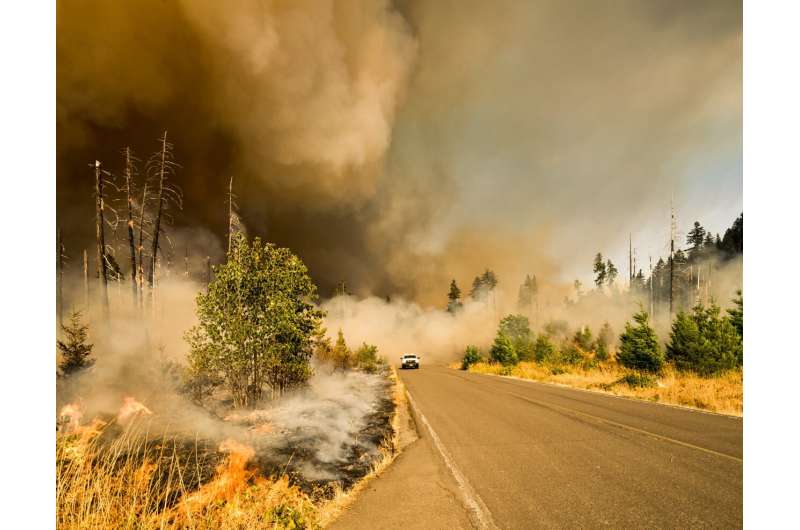This article has been reviewed according to Science X's editorial process and policies. Editors have highlighted the following attributes while ensuring the content's credibility:
fact-checked
trusted source
written by researcher(s)
proofread
As wildfires become more frequent and intense, how will persistent smoke exposure affect long-term health?

Wildfire smoke has become a common feature of Canadian summers, fueled by bigger, more intense and more frequent wildfires. In 2023, Canada experienced its worst wildfire season on record, with many communities contending with weeks of hazy, orange skies and frequent air quality alerts.
The 2024 wildfire season started early, with fires currently burning across much of western Canada. Ongoing wildfires near Jasper, Alta. have prompted widespread evacuation and blanketed the province in smoke, triggering air quality advisories.
As climate change increases temperatures, dries out forests and exacerbates drought conditions, our exposure to wildfire smoke is likely to increase.
Air quality impacts of wildfire smoke
Although Canada has seen notable improvements in air quality over the past 30 years, increasingly frequent and intense periods of wildfire smoke threaten to undo this progress. In the last two decades, while emissions from most pollution sources declined, Canadians' exposure to wildfire smoke has increased by approximately 220 percent.
As a result, in places impacted by wildfires, the annual average concentrations of PM2.5 are now increasing for the first time in several decades. PM2.5 (particulate matter that is smaller than 2.5 micrometers diameter) are the tiny particles in smoke that impact our health.
As emissions from other sources of PM2.5 continue to decline, wildfires will become the dominant source of particle pollution in Canada, changing when, how often and how much people are exposed to pollution, and how air quality is managed. For many, checking the local air quality will become as routine as checking the weather forecast.
As communities are exposed to wildfire smoke more regularly and over longer durations, year after year, it is critical to consider what these changing exposure patterns mean for our health.
Longer-term health implications of wildfire smoke
Wildfire smoke has historically been considered by public health professionals and air quality managers as a sporadic, short-term exposure, given the previously intermittent and infrequent nature of wildfires. Research on wildfire smoke reflects this, with most studies focused on the influence of exposure over days to weeks on acute health outcomes such as asthma exacerbations or cardiac arrests.
However, as wildfire smoke becomes a more frequent and persistent feature of summers in North America and around the world, researchers have begun to consider the longer-term health implications.
There is growing evidence that exposure to wildfire smoke over the course of a year or more is linked to premature mortality, with one study estimating that long-term exposure causes 570 to 2,500 early deaths per year in Canada. Wildfire smoke may also reduce lung function in the years following exposure, and living near wildfires may increase the risk of certain lung and brain cancers.
Prolonged exposure to wildfire smoke has also been linked to poorer standardized test performance among students and increased risk of dementia in older adults. Exposure during pregnancy may also increase the risk of pre-term birth and low birthweight, both of which are threats to health and quality of life throughout childhood.
Decades of research on the chronic health effects of PM2.5 from non-wildfire sources support this emerging evidence for wildfire smoke. In fact, there is some indication that the particles in wildfire smoke may be more toxic to human health than the particles from other sources, potentially due to differences in particle composition or the combined effects of wildfire-generated particles with other pollutants in smoke.
While it is increasingly clear that exposure to wildfire smoke poses a threat to our long-term health, more research is needed to address unanswered, but critical questions, such as:
- If a child is exposed to wildfire smoke summer after summer, what does this mean for their health in adulthood?
- Which poses a greater risk to our health: shorter periods of extreme smoke or longer periods of mild smoke?
- What are the best strategies for reducing the long-term health risks of wildfire smoke, which unlike other sources, cannot be controlled directly through legislation or technology?
As researchers continue to investigate the implications of prolonged and repeated exposures, there are steps Canadians can take to reduce health risks. Pay attention to local air quality alerts, understand your personal risk and know what actions you can take on smoky days. These measures will mitigate the immediate health risks of exposure and may play an important role in protecting your health years down the line.
This article is republished from The Conversation under a Creative Commons license. Read the original article.![]()




















